Apple's 2010 MacBook Air (11 & 13 inch) Thoroughly Reviewed
by Anand Lal Shimpi on October 26, 2010 10:08 PM EST- Posted in
- Mac
- Apple
- MacBook Air
- Laptops
I remember falling in love with the original MacBook Air. It wasn’t the styling that won me over, but rather the combination of performance, form factor and battery life. I needed a notebook fast enough for me to get work done when necessary, but with long enough battery life to last me through a trip across the country. Back in 2008, the MacBook Air was the perfect solution to that problem.
The original MacBook Air had three main issues. It was hot, the 1.8” HDD was unbearably slow, and it shipped with 2GB of memory that you couldn’t expand to 4GB. It was a great machine for writers as you could open up TextEdit and hammer out a document for five hours straight. And when you needed to, you had the greater-than-Atom performance to get more intensive work done.
What prompted me to stop using the MacBook Air was the second generation unibody MacBook Pro. Apple ramped up battery capacity enough where I could get much better battery life and performance out of the MacBook Pro. The combination of the two was enough for me to let my MacBook Air collect dust. I hardly ever used it after that point.
Apple updated the MacBook Air hardware since its original release, but the updates were nothing spectacular. Apple moved from an Intel supplied chipset to one made by NVIDIA, and SSDs eventually became standard issue. Battery life didn’t get any better and memory sizes never moved beyond 2GB.
Last week Apple announced the biggest upgrade to the MacBook Air since 2008, complete with a redesign, price reduction and improved internals. Let’s start at the redesign.
There Once Was One, Now There's Two
The original MacBook Air was very light on connectivity. It had an angled MagSafe power connector but that was it for visible ports. The right side of the machine was home to three hidden connectors: mini DisplayPort, USB and line out.

The new MacBook Air (left) vs. the old MacBook Air (right)
The new design forgoes the rounded nature of its predecessor and introduces more angular surfaces toward the rear of the machine. Connectors like flat surfaces so Apple outfitted the new MacBook Air with a pair of USB ports (one on each side) in addition to the MagSafe connector, miniDP out and line out. Everything is fully accessible from the start, nothing is hidden behind any secret panels.
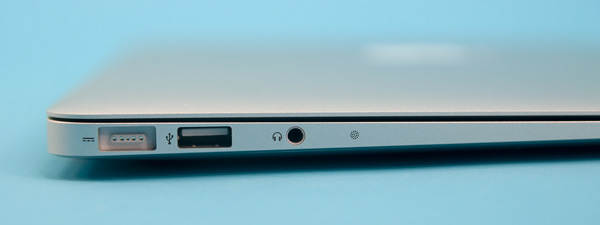
From left to right: MagSafe Power Connector, USB 2.0 port, headset jack, microphone
Next to the headset jack on the left side is the integrated microphone. Apple states it is an omnidirectional mic, but its placement is curious given the original MacBook Air had its mic at the top of the screen bezel. The microphone’s left leaning location didn’t negatively impact audio performance in our tests. As long as you’re not sitting to the right of a horribly noisy person/animal/box you should be good to go.
There are of course now two MacBook Airs that make up the family: an 11.6-inch model and a 13.3-inch model. The two have identical port layouts however the 13-inch MacBook Air gets an integrated SD card reader like its Pro siblings.
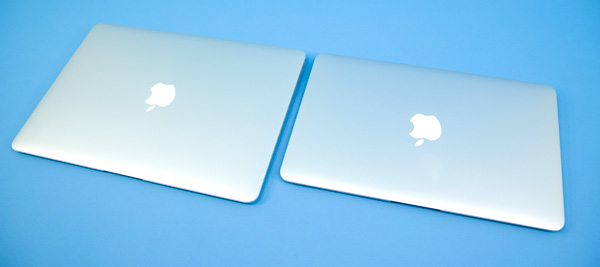
13-inch MBA (left), 11-inch MBA (right)
There’s a 0.6 pound difference between the two models and associated difference in dimensions:
| MacBook Air Size Comparison | ||||
| 11-inch | 13-inch | |||
| Height | 0.11 - 0.68" (0.3 - 1.7 cm) | 0.11 - 0.68" (0.3 - 1.7 cm) | ||
| Width | 11.8" (29.95 cm) | 12.8" (32.5 cm) | ||
| Depth | 7.56" (19.2 cm) | 8.94" (22.7 cm) | ||
| Weight | 2.3 lbs (1.06 kg) | 2.9 lbs (1.32 kg) | ||
Prices and specs differ as well. The 11-inch starts at $999 while the 13-inch starts at $1299. You can get faster CPUs in the 13-inch, while GPUs and memory options remain the same across the line. SSDs are not only standard but they're the only option for storage on the Airs. Given my infatuation with SSDs, you won't see me complaining. I'll be happy when Apple ships all of its systems with SSDs in their default configurations.
| MacBook Air Spec Comparison | |||||
| 11-inch | 13-inch |
13-inch (Late 2008)
|
|||
| CPU | Intel Core 2 Duo 1.4GHz (1.6GHz optional) | Intel Core 2 Duo 1.86GHz (2.13GHz optional) | Intel Core 2 Duo 1.86GHz | ||
| Memory | 2GB DDR3-1066 soldered on-board (4GB optional) | 2GB DDR3-1066 soldered on-board (4GB optional) | 2GB DDR3-1066 soldered on-board | ||
| GPU | NVIDIA GeForce 320M | NVIDIA GeForce 320M | NVIDIA GeForce 9400M | ||
| Storage | 64GB SSD (128GB optional) | 128GB SSD (256GB optional) | 128GB SSD | ||
| Connectivity | 802.11a/b/g/n Bluetooth 2.1 + EDR | 802.11a/b/g/n Bluetooth 2.1 + EDR | 802.11a/b/g and draft-n Bluetooth 2.1 + EDR | ||
| Battery Capacity | 35 Whr | 50 Whr | 37 Whr | ||
| Dimensions |
11.8 " x 7.56 " x 0.11 - 0.68" (29.95 cm x 19.2 cm x 0.3 - 1.7 cm) |
12.8 " x 8.94 " x 0.11 - 0.68" (32.5 cm x 22.7 cm x 0.3 - 1.7 cm) |
12.8 " x 8.94 " x 0.16 - 0.76" (32.5 cm x 22.7 cm x 0.41 - 1.9 cm) |
||
| Weight | 2.3 lbs (1.06 kg) | 2.9 lbs (1.32 kg) | 3.0 lbs (1.36 kg) | ||
| Price | $999 | $1299 | $1799 | ||
Memory & CPU Upgrades: Good News and Bad News
I always like hearing the bad news first so I’ll treat you all no differently. The new MacBook Air not only comes with a meager 2GB of memory, but it’s also soldered onto the motherboard just like in the previous generations.
Now the good news: after two years of complaining Apple has finally added a 4GB memory option. It’s not end user upgradeable, but for an extra $100 Apple will solder 4GB of memory onto the MacBook Air’s motherboard instead of 2GB.
If you’re really just going to be using this thing for writing, IMing and browsing the web - 2GB is fine. If you plan on doing more than that, you should consider spending the $100 on the 4GB upgrade. Right now I’m using 1.46GB of memory. I can edit only a handful of photos in Photoshop before I start swapping to disk.
Apple priced CPU upgrades similarly, but there’s a catch. The base $999 and $1299 (11/13-inch) MacBook Airs can’t be the recipient of an upgraded CPU. You have to go to the upgraded 11/13-inch configurations, which are both $200 more expensive before you get the option to upgrade the CPU for another $100. The upgraded models just give you larger SSDs and nothing else, so if you don’t need the space then the seemingly affordable $100 CPU upgrade actually ends up being a $300 upgrade.
If you want my advice I’d stick to the base systems so long as your needs are simple. However if you plan on doing any amount of multitasking or heavy work (e.g. content creation, editing) on this machine I’d recommend at least the $100 memory upgrade to 4GB. And if you plan on keeping the MacBook Air for a while, spring for the upgraded CPU. It’ll make the later years of its life a little more bearable.
The Trackpad
Going back to my old MacBook Air was always weird. It lacked the glass trackpad that I’d grown accustomed to. The trackpad just felt rough. The new Airs move to the same type of glass trackpad as the rest of Apple’s mobile lineup. Also gone is the traditional mouse button, the glass trackpad pivots at the top so the entire surface acts as a mouse button.
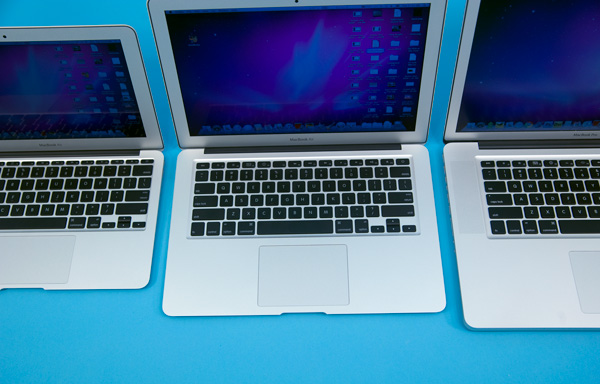
From left to right: 11-inch MBA, 13-inch MBA, 15-inch MBP
Multitouch gestures are supported by the glass trackpad.
No Optical Drive, OS X Recovery via USB Stick
The original MacBook Air didn’t have an optical drive. The new models are no different. When I bought my first Air I actually purchased the external SuperDrive, thinking I’d use it. To be honest, I’ve only used it when doing weird things to the MacBook Air for reviews on AnandTech. I won’t go as far as to say that no notebooks need optical drives, but the absence of one in the MacBook Air isn’t that big of a deal.
Unlike the original MacBook Air, Apple doesn’t bundle these two puppies with recovery DVDs. In case you get an 8GB USB stick with OS X and all bundled apps on the drive. If you need to restore your machine, pop the USB stick in and hold down the ‘c’ key while you start the Air. Apple was even kind enough to etch the version of the OS and application suite on the USB stick itself in case you accumulate a bunch of these over time.
I must say this is the ideal way to distribute OS X recovery software. The USB stick isn’t write protected so you could always do something silly like erase it, but I’m willing to take that risk for the convenience benefit. I expect that next year’s MacBook releases may bundle a similar stick if Apple is feeling particularly forward looking.
No Backlit Keyboard, No Ambient Light Sensor, Same Old Power Brick
Neither of the new MacBook Airs have a backlit keyboard. I do a lot of writing in bed at night and I do miss the backlit keyboard. For touch typists it’s not a problem, but if you switch between the MacBook Air and other computers regularly you’ll find yourself fumbling for the function keys in the dark. I'm guessing this was a cost savings measure.
The top of the screen bezel only has a cutout for the VGA camera, there’s no ambient light sensor. That means you don’t get auto adjusting screen brightness (which some may consider a good thing).
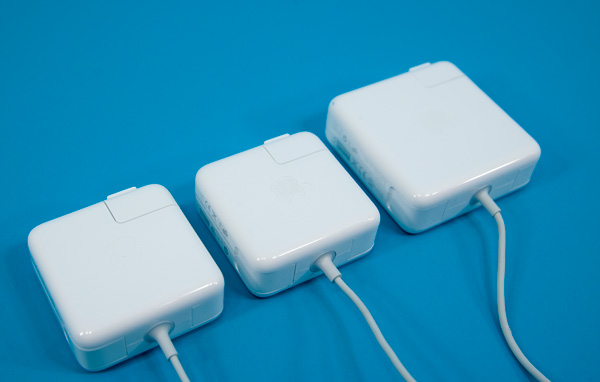
From left to right: new MBA power adapter, old 2008 MBA power adapter, 2010 MBP power adapter
Both Airs come with the same 45W MagSafe power adapter, which just happens to be the same power adapter as the old 2008 MBA (with a new connector of course):
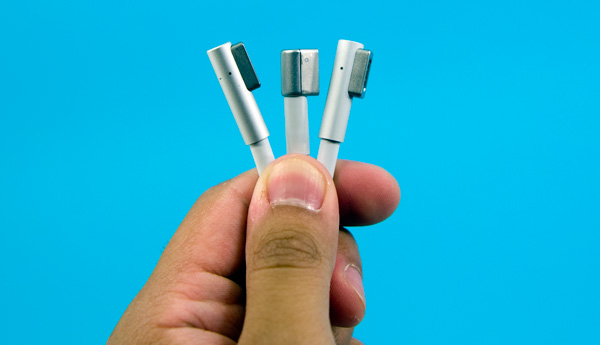
From left to right: 15-inch MBP power connector, 2008 MBA power connector, 2010 MBA power connector
No Flash Installed by Default
So this is weird. The new MacBook Airs are the first Macs to ship in a long time without Adobe's Flash Player plugin installed by default. That's right, if you open your brand new Mac, launch Safari, visit youtube.com and try to watch a video you'll get this screen:

Apple encourages its users to go download the latest version of Adobe's Flash Player to enable the functionality, but this flies in the face of Apple's "it just works" usage model. Watching flash video no longer just works on Macs. You have to go out and download something to make it work. It sounds awfully PC like (gasp!).
Obviously Apple isn't the biggest fan of Flash. The technology isn't supported (and most likely never will be) on iOS. Removing it from the default OS X install makes Apple's intentions clear: it wants Flash dead.
There's also the security aspect. Apple wants to keep its OS as secure as possible and Flash vulnerabilities have been a problem in the past. By not shipping OS X with Flash on it, Apple avoids shipping an old, out of date and potentially vulnerable version of the player software on its Macs. And by forcing users to download the latest version they'll hopefully have a more secure copy on their Macs.
Now whether or not this next bit is a coincidence I'm unsure of. Two of our battery life tests involve loading web pages with Flash on them. My 13-inch MBA sample would throw this error almost every 60 minutes on the dot during the test:

The issue didn't happen on the 11-inch MBA, nor on any of the other MBPs I've run the battery tests on. I've looked around and can't seem to find other reports of Flash being unusually unstable on the new MBAs so it's quite possible that this is an isolated (but unusually repeatable) problem. I've alerted Apple and I'm trying to see if they can reproduce it on any other hardware aside from my 13-inch model. What bothers me is that the the error is very reproducible. I'm going to keep pounding on the system to see if I can figure out what's going on. If I find anything, rest assured I'll publish it here.


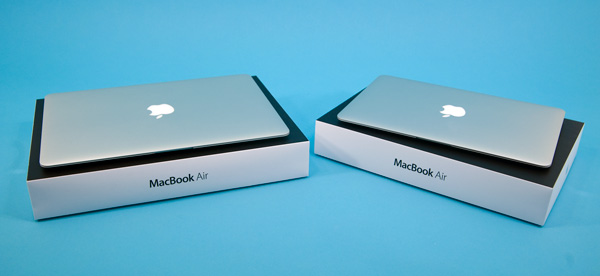
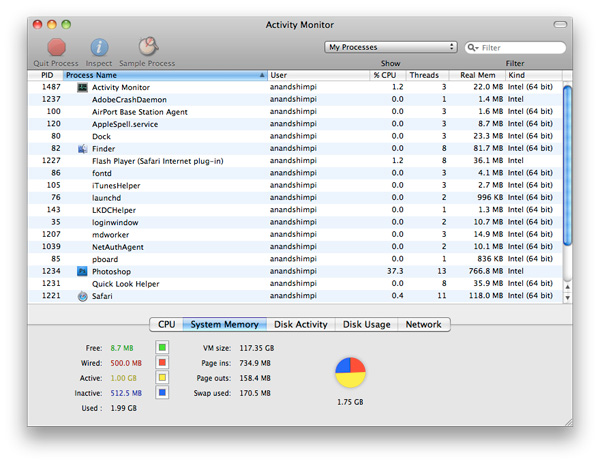
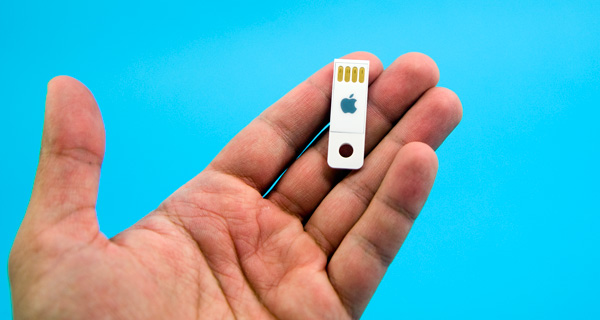
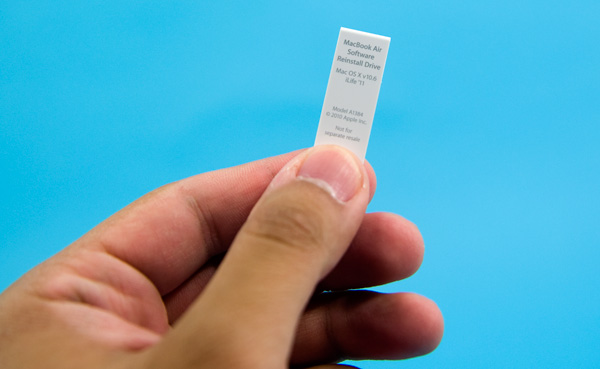
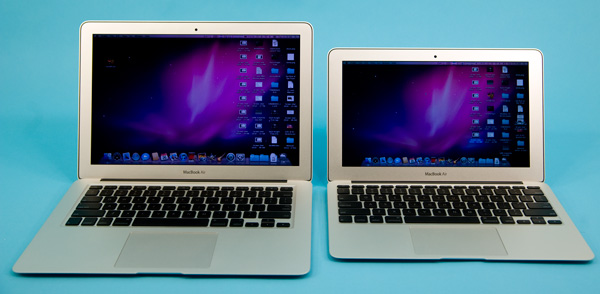








185 Comments
View All Comments
Anand Lal Shimpi - Wednesday, October 27, 2010 - link
Not at all. But workloads, even within a given field, have grown much more intense over the past 5 years. While my example was simply photo editing, compile times for large projects should also be much longer on the 11 compared to any of the Core i-series platforms today. I'm not saying it can't be done, I'm saying you'll begin to impact productivity as a result.Obviously what you do for a living is real work - it'd just take longer on the 11-inch MBA vs. one of the MBPs.
Take care,
Anand
lemonadesoda - Thursday, October 28, 2010 - link
I've added a different usage picture for comparison. My "real work" workflow is something like this:1/ Read emails
2/ Read attachments, e.g. word, excel, PDF documents
3/ Take phone calls on VoIP/skype
4/ Log in to corporate webserver, check activity
5/ Send emails
6/ Write offers, workplans, status reports, invoices, in word. Convert to PDF
7/ Review training material/videos incl. created by us on SD card
8/ Fool around on the web during breaks
9/ Check anandtech
10/ Check emails
11/ Prepare articles and presentations, use a beamer (VGA D-SUB)
12/ Online banking
My "real play" workflow is something like this
1/ Read emails
2/ Fool around on the internet
3/ Play a few flash games with my kids
4/ Download pictures from camera on SD card
5/ Check, select, fix, upload to fileserver/website
6/ Download a video from my camcorder
7/ Upload to youtube
8/ Read anandtech
No, I do not expect to use my "netbook" for DirectX gaming. Not sure why everyone wants to do this. Havent they got a full-size desktop for this. A "netbook" has a different life-purpose and shouldnt be expected to replace a desktop.
On an Atom netbook, my workflows struggle with the video material and skype video. Skype audio is OK.
On the Apple 11" the workflows would be fine except we are missing the SD card slot. PITA for me. Not sure how we would connect to a beamer. I guess some kind of "converter dongle" would be needed to get from displayport to D-SUB VGA which is what 99% of beamers (and their room installations) require.
titeroper - Wednesday, October 27, 2010 - link
Anand and gang and fellow forumites - I know I may be shot down for asking this, but perhaps for xmas, can you write a quick article on how you think Apple will deal with Sandy Bridge upgrades early next year for MBP's?How does Nvidia fit in? Is there space for both a dedicated 400m series GPU + Intel HD and Sandy Bridge? Is it as easy as updating the current 2010 config with these parts?
I hope someone can help answer here, as I am looking forward to this update come Q!/Q2 2011.
Pantsu - Wednesday, October 27, 2010 - link
I'll soon update my old white macbook of early 2008, but this isn't quite up to snuff. While the form factor is superb, everything else is not. Weak CPU, only 2GB memory, limited although fast storage, and of course the price. It's probably better to wait for Sandy Bridge or Zacate in early 2011. Those should really bring something new, and I hope Apple will update the MacBook Pro at that time, otherwise I'll have to go Windows again, which I don't care to do in a laptop environment.new-paradigm - Wednesday, October 27, 2010 - link
Just looking at the specs of the 11.6" MBA, and the fact that it's 11.6" ... can apple honestly claim not to be in the netbook game anymore?Seriously, any laptop under 12" in screen size is a netbook, and bizzarely apple's reasoning behind omitting the dvd drive and other sundry pieces of usual hardware/connectivity (i.e. expected use and target audience) is almost exactly the same as those used when explaining their omission on netbboks.
SraCet - Wednesday, October 27, 2010 - link
The term "netbook" was coined to describe the small cheap laptops that were coming out a couple years ago with 7" screens, miniature keyboards, and barely enough storage space to run Linux. NETbook because they were only powerful enough to do basic web surfing--get it?Now everybody is calling every small laptop a "netbook," I guess because the word sounds cool, and everybody has their own made-up criteria for what is and isn't a netbook.
If you want to arbitrarily declare that anything with a < 12" screen is a netbook then fine. But surely you realize this isn't what Steve Jobs was referring to when he expressed his displeasure with "netbooks."
lemonadesoda - Thursday, October 28, 2010 - link
The word "netbook" is a living and evolving term. I don't think it was coined to have a fixed meaning of "cheap and 7 inch" and nothing else! Many years ago a laptop was something that was 11-13". Now we have laptops with 15" and 17" screens. Nobody is shouting "you cant call it a laptop, it doesnt sit on your lap anymore". The term laptop has evolved. Just as has the term desktop. Does desktop have to mean a very expensive Intel 386 with ISA, PCI, floppy and VDU? No, of course not.I think it is better to let the term netbook be defined as a "underspecced compared to a workstation" and "portable enough to put in your briefcase" and "powerful enough to run "net" applications" then I think we can allow the Apple 11" to be called a netbook. It is helping to redefine the term netbook perhaps, just like a mercedes or bmw has redefined our expectations of what a car is, or can be.
webdev50 - Wednesday, October 27, 2010 - link
Unfortunately, reviews like these don't consider how these machines will hold up after you start using them on a daily basis. Apple's equipment is developing a notorious reputation for having quality control issues. Search TS2377 on Google. Apple is using commodity hardware just like other manufacturers do, so Apple's equipment is prone to failure like everyone else's, regardless of price.My 2008 MacBook Pro 17" was repaired twice for the same Nvidia issue within a couple of months this year, so I switched to a Windows 7 machine instead because I need a reliable computer. I still have my MacBook Pro, but I'm running a stress test on it 12 hours a day trying to break it so I can get it replaced from Apple. When I get the replacement, I'm not even going to open the box; just sell it on craigslist.
Sure, OS X is pretty, but what good is it if the hardware is unreliable? And I can't legally use OS X on anything but Apple hardware. (Besides, after using Mac OS X software for 7 years, I've actually found it to be quite limiting and not as robust and mature as Windows software.) I'm not going to buy more than one Mac just so I can have a spare to use while Apple spends weeks repairing my computer.
Dealing with the "Geniuses" at the Apple Store can be very unpleasant too. When I called Apple Tech Support to verify what I was told at the Apple Store, they suggested I go to another Apple Store.
What am I supposed to use when my Mac breaks down and is getting repaired? It's cheaper to buy two Windows machines if one of them needs to be repaired than to buy one Mac.
My perspective now is not to buy anything from Apple that can't be immediately swapped if it's faulty. An iPhone or iPod can be quickly swapped out. Macs need to go through Apple's three-ring circus to get repaired. And who knows what the gorillas in the back room are going to do with it (and the spinning hard drive)? After I got my machine back from them, I needed to clean the lens on the DVD drive so I could burn a backup DVD. I don't want to know what they stuck in my DVD drive.
iwodo - Wednesday, October 27, 2010 - link
Isn't that a known issues that happen on ANY nvidia Gfx Laptop?AMDJunkie - Wednesday, October 27, 2010 - link
iwodo is right. HP, Dell, anyone who used the mobile (and desktop) Nvidia 8600 chip was affected. Research "bumpgate."I think Apple's pretty damn generous to have a program in place to replace your logic board, even out of warranty, seeing as just last month Nvidia finally settled and made a page for owners of PCs with the afflicted chips to get refunds or repairs. If you had an HP, I had heard (hearsay, now), that if you were out of warranty, tough, and this was the only (and only recently available) recourse.
I know for a fact that Apple's not as generous to give you a whole new model though, as long as it's for the graphics issue. Your best bet is to go here:
http://www.nvidiasettlement.com/